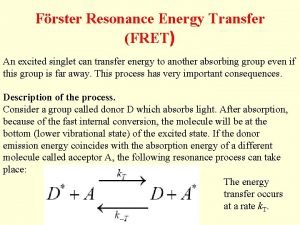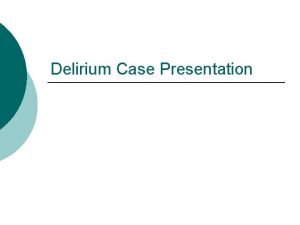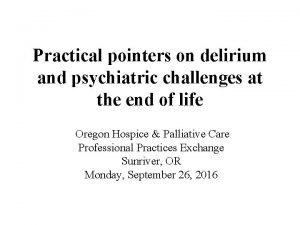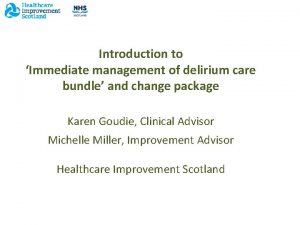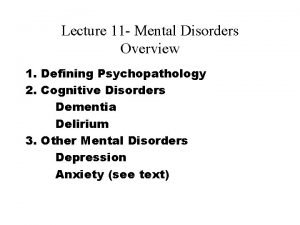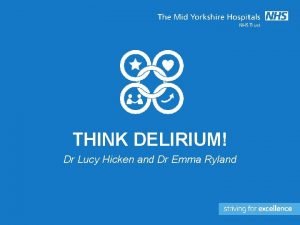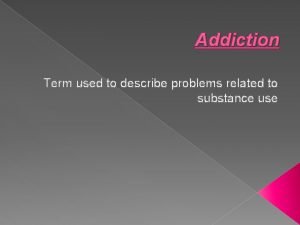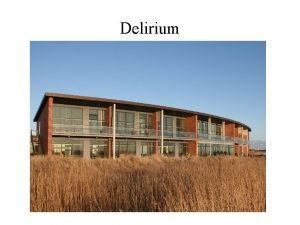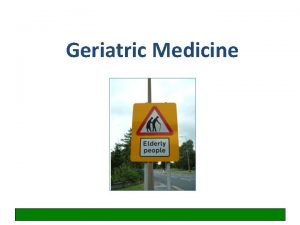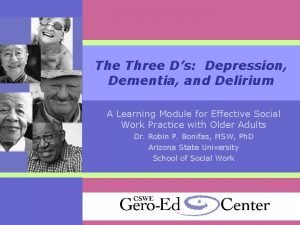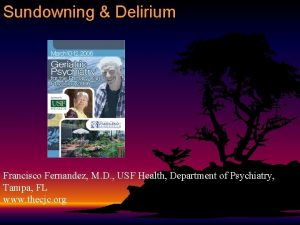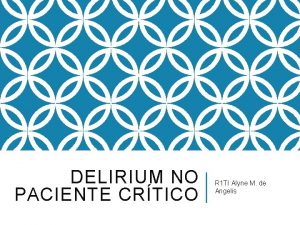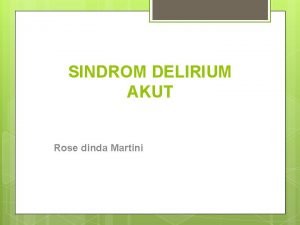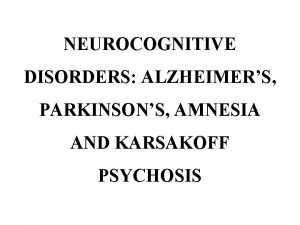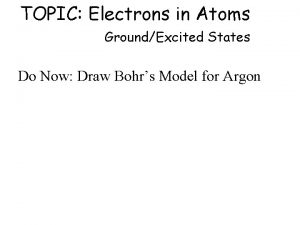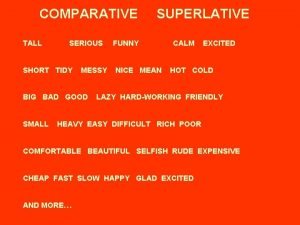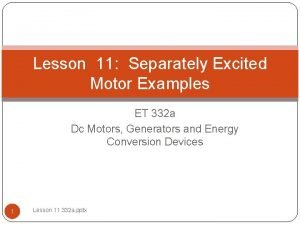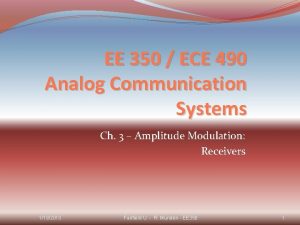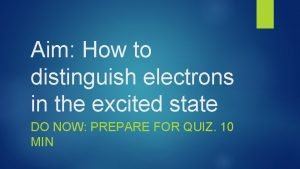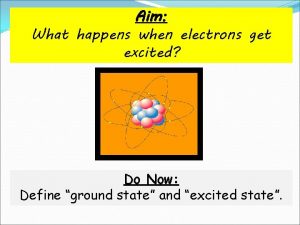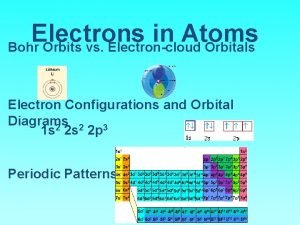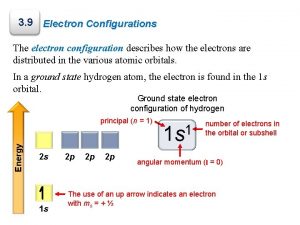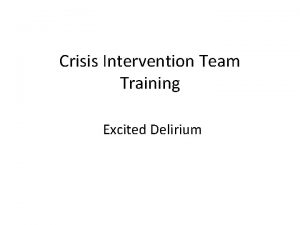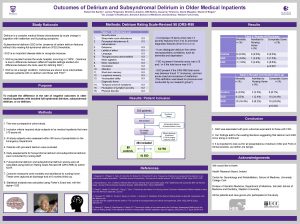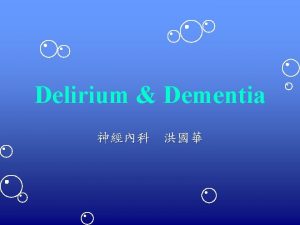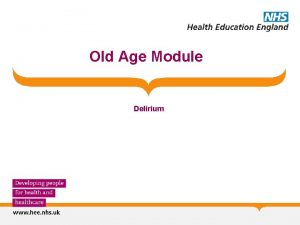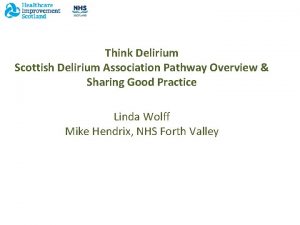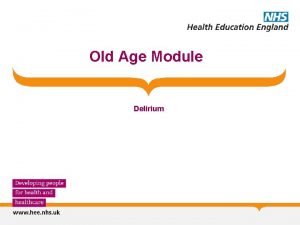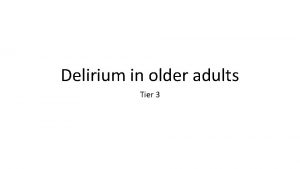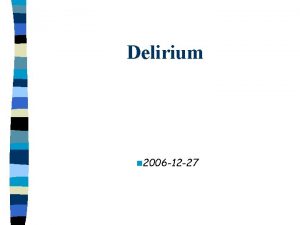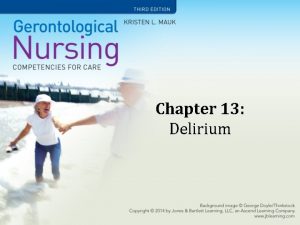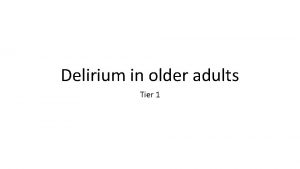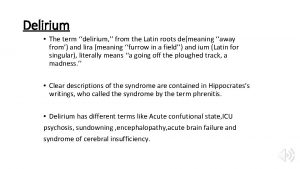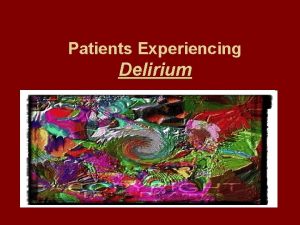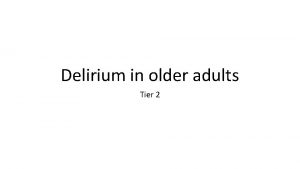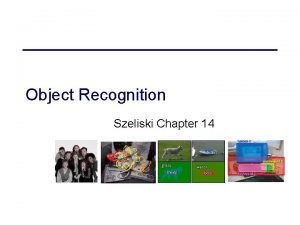Excited Delirium a medical condition Excited Delirium Recognition
























































- Slides: 56

Excited Delirium: a medical condition. Excited Delirium: Recognition and Treatment Joseph Lewis, M. D. , Medical Director, Honolulu Emergency Services Division

Excited Delirium It’s Chaotic Fury • It’s not just agitation

Excited Delirium: Goals • Understand what is Excited Delirium. • Understand how patients die from it. • Understand how to recognize it before patients die: NOTACRIME • Understand how to treat it: CHILLBUS • Understand bonus stuff: pathophysiology

Part 1: What is Excited Delirium?

Excited Delirium: Not a Crime • Historically, a naked, screaming and agitated individual standing in a busy roadway during rush hour traffic required law enforcement response. • Police were expected to remove the subject from the roadway and take him to an appropriate facility.

Excited Delirium: Not a Crime • When force was used to subdue the subject, injuries were common and EMS responded at the request of the police to treated the injuries. • Medical treatment was focused upon clearing the subject for incarceration into a jail facility. • Unfortunately, this scenario sometimes resulted in the untimely and unnecessary death of the person with excited delirium.

Unrecognized Excited Delirium is frequently a violent spiral towards death. • Victims of excited delirium display sudden onset of paranoia and alternate between calm behavior and extreme agitation. • When confronted by police, who are invariably called to the scene, the victim intensifies the violence and paranoia. • An intense struggle ensues, when the victim exhibits incredible "superhuman" strength and is impervious to the usual police techniques of pain control, including pepper spray, baton strikes, and in certain cases TASER deployment.

Unrecognized Excited Delirium is frequently a violent spiral towards death. • The intense struggle requires the efforts of many police officers, who are finally able to restrain the victim. • Usually within minutes of being restrained, the victim loses all vital signs and is suddenly dead. Core body temperatures average 105 degrees. • Resuscitation of these cases often results in a failed course of hospital treatment, characterized by a fatal sequence of rhabdomyolysis and renal failure.

Excited Delirium: What is excited delirium? • It is now known that some of the time this situation should be viewed as a "medical crisis" and not a “crime”. • The person needs “medical treatment” not “apprehension”. • Because the police are usually the first to come in contact with excited delirium patients during a call for service involving a subject who is aggressively violent they need to be trained to recognize “excited delirium”.

Excited Delirium: What is excited delirium? • Law enforcement officers will still be required to use force to control these patients, however they also need to be trained to summon help immediately if they suspect the individual is suffering from excited delirium symptoms. • By training law enforcement officers and EMT’s to recognize excited delirium we can potentially reduce the incidence of “in custody deaths” from this condition.

Excited Delirium: Not a Crime • The Key here is the “Delirium” part • We must understand the delirium part of “excited delirium”. • Delirious people are inattentive, they don’t pay attention. • The part of their brain which helps a person accurately assesses their surroundings and respond appropriately to authority figures in a reasonable manner isn’t working. • “Their reason appears to have left the building”.

Excited Delirium: Not a Crime • The Key here is the “Delirium” • Their reasoning ability has left. • Their processing capability has left. • They seem to refuse to listen, when in actuality they often can hear but can’t process. • They are suffering from delirium.

Excited Delirium: Not a Crime • The Key here is the delirium part of “excited delirium”. • They not just drunk, high or buzzed, they are delirious • They aren’t just rude or disrespectful, they’re delirious. • This is a medical illness.

Excited Delirium: Not a Crime • The Key here is the delirium part of “excited delirium”. • They respond to all types of stimulation in an exaggerated fashion, light, sounds cause agitation and physical touch seems to cause extreme agitation. • When physically confronted they enter a mode where they appear to be fighting for their life and struggle uncontrollably until they suddenly die.

Excited Delirium: Not a Crime • Delirium is a medical condition. • It is a medical illness characterized by a lack of attention and a lack of processing ability for visual and auditory stimulus. • That means they see the Police, but they don’t process them as Police. • They hear the officers orders, but they don’t process it. • They respond to physical force with extreme agitation. • Unless we understand this we get into a physical confrontation in which they refuse to yield until they are completely exhausted and or die. • They literally fight to the death.

Excited Delirium Part 2? How Do they Die? Why Do they Die?

What causes Death in Excited Delirium? Terms we need to understand to prevent deaths; Positional Asphyxia Compression Asphyxia Physiologic issues Metabolic issues Pre-existing medical conditions Stimulant Use

Excited Delirium: Not a Crime • Asphyxia the definition of "asphyxia" is complex and often means more than hypoxia or lack of oxygen. • In the legal field of forensic pathology asphyxia is considered to be a consequence of a struggle to breathe against some mechanical interference with respiration.

Excited Delirium: Not a Crime • Positional Asphyxia is a form of asphyxia which occurs when body position prevents adequate breathing, such as from upper airway obstruction or a limitation in chest wall expansion. It usually occurs when a person with severe respiration muscle fatigue is restrained in a position that impairs or prevents breathing. • This typically occurs when a person is face down. In this position the person can’t breath well due to the weight of their body on their chest and their state of exhaustion from vigorous physical activity. This causes the respiratory arrest (stops breathing) which is quickly followed by cardiac arrest (heart stops pumping). They are at this point clinically dead.

Excited Delirium: Not a Crime • Compression Asphyxia A form of asphyxia which occurs when a force or weight prevents adequate gas exchange, such as a force applied to the neck, chest or back or due to the weight of his restrainers on his chest, back or neck. Usually he is face down and his restrainers are on his back. Due to the extra weight on the back of the chest they can’t breathe. The more they struggle, the more weight is added in a endless cycle ending in death. Combine exhaustion with restricted breathing and when they can’t muster the energy to take another breathe, respiratory arrest occurs and is quickly followed by cardiac arrest. Suddenly their dead. •

Why Does This Happen? These patients are violent and are forcibly restrained by multiple police officers and after a usually long struggle, end up hand cuffed, prone and exhausted in the back seat of a car or end up prone and exhausted on the ground with multiple people leaning or laying on them to stop their combative behavior.

Excited Delirium: Not a Crime • Positional and compressional asphyxia are terms frequently heard in civil courtrooms. • Several successful lawsuits have occurred over deaths while the person was in the prone position while officers were laying on their back and other lawsuits were filed when death occurred in the back of the police car while the person lay prone on the seat during transport with handcuffs on. • Almost all in-custody deaths result in some type of litigation, usually with a focus on the method of control. • Methods of restraint become issues of contention in a lawsuit and may be the turning point in the liability of a law enforcement agency.

Excited Delirium: Not a Crime • Metabolic issues-acidosis, hyperkalemia • Pre-existing medical conditions- cardiac conditions like cardiomyopathy , asthma or COPD • Stimulant Use like methamphetamine or cocaine • These issues decrease the patients cardiac and respiratory reserve, so when they are physically stressed they decompensate and die sooner then if they were healthy.

Excited Delirium Deaths How big a problems is this? It depends on where you live and what the illicit drugs are used where you live. Cocaine and methamphetamine are frequently used by persons who die due to excited delirium.

Stats on Positional asphyxia Los Angeles County 216 Case-Hobble Restraint Patient Deaths in one year Majority Found Prone by EMS All had struggled with the Police All had developed labored breathing All had unanticipated sudden cardiac arrest

Part 3: Excited Delirium How do we recognize it so they don’t die? Hint: NOTACRIMINAL

Think Excited Delirium when the patient displays: Sudden Bizarre Behavior Hyperactivity Combativeness Super-Human Strength Paranoid Delusions Shouting Hallucinations Hyperthermia

Other Signs of Excited Delirium Inability to Concentrate Extreme Restlessness Inability to remain still Flailing Diaphoresis Flushed skin Extreme Tachycardia Shedding of clothes Attraction to glass windows or mirrors

Excited Delirium: Not a Crime • That’s a big list. • You are probably wondering how you will ever remember it. • Well it is easier with the following pneumonic. • Dr. Michael Curtis has developed the following mnemonic: "NOT A CRIME. “ to characterize this situation and help law enforcement and EMS remember the signs and symptoms of excited delirium.

Excited Delirium: How do we recognize it? • Naked = stripping off clothing and sweating profusely • Objects = recall violence against objects, especially glass, shiny objects • Tough = the person is very strong, unstoppable, seemingly endless endurance, and a diminished pain or insensitivity to pain • Acute onset = You are told the person “just snapped” • Confused = The person is unsure who (s)he is, where (s)he is located, why (s)he is there, and lacks perception • Resistant = The person cannot or refuses to follow commands to stop his or her behavior. • Incoherent speech = The person is shouting; bizarre content • Mental health issues or Makes you feel uncomfortable • Early EMS request, back-up request, and supervisor request.

Excited Delirium: How do we recognize it? • Naked = stripping off clothing and sweating profusely • Objects = recall violence against objects, especially glass, shiny objects • Tough = the person is very strong, unstoppable, seemingly endless endurance, and a diminished pain or insensitivity to pain Acute onset = You are told the person “just snapped”

Excited Delirium: How do we recognize it? Confused = The person is unsure who (s)he is, where (s)he is located, why (s)he is there, and lacks perception • Resistant = The person cannot or refuses to follow commands to stop his or her behavior. • Incoherent speech = The person is shouting; bizarre content • Mental health issues or Makes you feel uncomfortable, your instincts say mental illness • Early EMS, Police back-up, Supervisor and EMS.

Excited Delirium: How do we recognize it? • Naked = stripping off clothing and sweating profusely • Objects = recall violence against objects, especially glass, shiny objects • Tough = the person is very strong, unstoppable, seemingly endless endurance, and a diminished pain or insensitivity to pain • Acute onset = You are told the person “just snapped” • Confused = The person is unsure who (s)he is, where (s)he is located, why (s)he is there, and lacks perception • Resistant = The person cannot or refuses to follow commands to stop his or her behavior. • Incoherent speech = The person is shouting; bizarre content • Mental health issues or Makes you feel uncomfortable • Early EMS request, back-up request, and supervisor request.

Excited Delirium: Not a Crime • Thus Police, EMS and Fire need to create a cooperative strategy which treats this as a medical condition and not a criminal one, and involves: • 1. Early recognition • 2. Early EMS notification • 3. Strict avoidance of face down restraint, • 5. Prompt sedation, cooling and hydration • 6. Transport to hospital for medical treatment

Honolulu EMS Protocol: Excited Delirium E. D. • Dispatch Co-respond if Police request. • Police contact EMS if the person fits the NOTACRIMINAL Exited Delirium criterion. • Then Patient is: • Restrained by Police and then EMS takes over. • Remember scene safety and your PPE. • EMS assessment including vital signs, temperature, pulse oximetry and blood sugar • EMS communicates with a base station physician for permission to start CHILBUS protocol

Management of Excited Delirium • Personal Protective Equipment • Scene Safety • Patient restraint • Remember you can’t help the patient if you become a patient.

Restraint • Physical • The patient must be restrained first, so you don’t get hurt and they don’t hurt themselves! • Chemical • The goal is chemical restraint to stop the cascade of struggle, and metabolic deterioration which leads to death !

Management of Excited Delirium • Pneumonic C. H. I. L. B. U. S. • • • Calm down: Intranasal Versed, then IV Versed or Valium Cool down ice packs to armpits, groin and IV fluids Hypoxia/Hypoglycemia check pulse oximetry Accu-chek IV fluids for cooling, hydration, stop Rhabdo, Rx lactic H+ Lastly don’t lay down. Remember B. B. U. S. Better Breathing Upright Sitting.

Calm Down ! • Benzodiazepines are most useful, large doses well tolerated; Ativan & Versed. • Haldol and Droperidol can be used, but there use can cause EPS causing uncontrolled muscle activity and speeding up the metabolic spiral towards death, IV use can cause prolongation of QT causing sudden death from torsades de pointes.

Cooling • • Cooling is critical IV Fluids Limit Activity Ice Packs Groin and axilla

IV Fluids for Rehydration • These patients are hot, sweaty and have extreme physical activity. • IV hydration helps everything in their metabolic crisis, acidosis, dehydration, hyperkalemia and Rhabdomyolysis.

The End • The slides which follow are bonus material

Excited Delirium • The majority of cases of are related to drug use. • Cocaine seems to be the most common, however methamphetamine, alcohol, PCP and LSD have also be documented to cause excited delirium. • Patients suffering from psychiatric illness have the second highest rates of excited delirium syndrome and can be related to abrupt cessation of medications, undiagnosed or treated mania, and central nervous system adaption to certain medications. • There are other less common medical causes like hypoglycemia, hyperthermia, rare types of stroke, kidney failure or infection like meningitis or encephalitis.

Statistically Speaking Summer Months High Heat and Humidity High Body Mass Index Methamphetamine or cocaine use

Statistically Speaking Summer Months High Heat and Humidity High Body Mass Index Methamphetamine or cocaine use

Miami Dade Protocol: Excited Delirium E. D. • • Police contact EMS if: Patient Tasered by Police who fits E. D. criterion Then Patient is: Restrained by Police and then EMS takes over Sedation with Nasal Versed then IV Versed IV Bolus 2 liters of cold saline Sodium Bicarbonate Transport to ER with communication Patient enroute

Pathophysiology of Sudden Death • What Do We know about the Pathophysiology of Sudden Death in Excited Delirium

Lactate • These patients are struggling, agitated, flailing and have tremendous muscle activity which produces large amounts of lactic acid, which results in…. • Severe Metabolic Acidosis

Rhabdomyolysis • • Muscle Cells disintegrate Release muscle enzyme CPK and potassium Further alter acid base balance Contribute to dangerous electrolyte imbalances like hyperkalemia or kidney issues due to rhabdomyolysis

Hyperkalemia • Released from inside muscle cells • Can cause cardiac dysrhythmias • Must be treated

Hyperthermia • These patients have been shown to have temperatures of 106 degrees ! • No wonder they are frequently found naked or shedding their clothes.

Hypoxia • Mix together stimulant use, acidosis, electrolyte disturbances like hyperkalemia, Rhabdomyolysis, hyperthermia and add Hypoxia and you get an increased risk of sudden death.

Underlying Medical Conditions • Things which place the patient at risk of sudden death with exertion like: • Cardiac Disease • Lung Disease • Psychiatric Conditions with mania or psychosis

Hypoglycemia • Hypoglycemia must be watched for and treated as a cause of delirium and a complication of continued agitation

Hyperkalemia • • IV Fluids Bicarbonate Dextrose Insulin

Tidbits • HENDERSON, NV - The 2 nd Annual Sudden Death, Excited Delirium & In-Custody Death Conference focusing upon the latest medical research findings, theories, and legal issues about excited delirium, sudden death, electronic control devices, and jail suicide, which are of great concern for law enforcement agencies around the world, will be held on November 28 -30, 2007 at the Imperial Palace® Hotel, Las Vegas, Nevada. The three-day Conference is sponsored by the Institute for the Prevention of In-Custody Deaths, Inc. (IPICD), Henderson, Nevada.
 Energy transfer theory
Energy transfer theory Basic geometric features of symbology
Basic geometric features of symbology Delirium case presentation
Delirium case presentation Nash delirium
Nash delirium European delirium association
European delirium association Acute confusion related to
Acute confusion related to Lucie big delirium
Lucie big delirium Flocculation delirium
Flocculation delirium Terminalt delirium
Terminalt delirium Delirium definition
Delirium definition Difference between dementia and delirium
Difference between dementia and delirium Tingkat kesadaran gcs
Tingkat kesadaran gcs Difference between delirium and dementia ppt
Difference between delirium and dementia ppt Escala de cam icu
Escala de cam icu R
R Sindrom delirium akut
Sindrom delirium akut Difference between delirium and dementia table
Difference between delirium and dementia table Delirium care pathways
Delirium care pathways Psychological factors affecting medical condition
Psychological factors affecting medical condition Difference between medical report and medical certificate
Difference between medical report and medical certificate Torrance memorial medical center medical records
Torrance memorial medical center medical records Doctors license number
Doctors license number Cartersville medical center medical records
Cartersville medical center medical records Gbmc medical records
Gbmc medical records Serious comparative and superlative
Serious comparative and superlative Excited state electron configuration
Excited state electron configuration Peaceful superlative
Peaceful superlative Jenny puchovier was so excited theme
Jenny puchovier was so excited theme Show don't tell excitement
Show don't tell excitement A book of over 1 000 knock-knock jokes author's purpose
A book of over 1 000 knock-knock jokes author's purpose Superlative of taller
Superlative of taller Which russian leader does snowball most resemble?
Which russian leader does snowball most resemble? Excited is which part of speech
Excited is which part of speech Angie loved to draw theme
Angie loved to draw theme Classification of dc generator
Classification of dc generator Funny in superlative
Funny in superlative How does nick feel about meeting myrtle
How does nick feel about meeting myrtle Gift adverb
Gift adverb Drawbacks of trf receiver
Drawbacks of trf receiver Speech good morning everyone
Speech good morning everyone Simile for excitement
Simile for excitement Rpm of dc motor formula
Rpm of dc motor formula Self excited mixer
Self excited mixer Excited
Excited Excited
Excited What is the excited state electron configuration
What is the excited state electron configuration My very excited mother planets
My very excited mother planets Excited to get started
Excited to get started You excited
You excited Sinusoidally excited linear circuit
Sinusoidally excited linear circuit Shell and subshell
Shell and subshell Word for excited
Word for excited Adjectives ending in ed and ing
Adjectives ending in ed and ing Excited to get to know you
Excited to get to know you Electron configuration special cases
Electron configuration special cases Tictle
Tictle Bohr model for beryllium
Bohr model for beryllium
